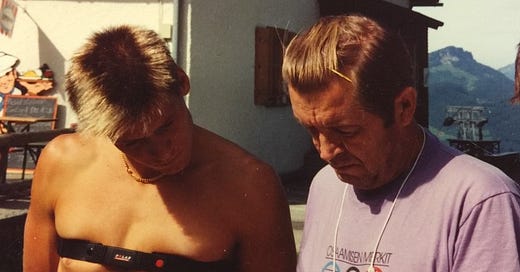Pauli Kiuru & Seppo Nuuttila
For five consecutive years, from 1990 to 1994, Finnish ironman triathlete Pauli Kiuru based himself in Christchurch during our summer to prepare for the upcoming Northern Hemisphere season. After more than eight hours of racing, his sensational sprint finish with American Ken Glah at the 1990 Kiwi Lager New Zealand Ironman catapulted him to fame in New Zealand and worldwide.1
From 1991 to 1994, he stopped in Australia to participate in the Australian Ironman on his way home to Finland. He won it every year for those four years against top international competition. It was an impressive display of consistency, something that became his trademark. He rarely finished outside the top three in any race he entered. In the Hawaii Ironman, he came third in 1990 and 1992 and second in 1993 to the great Mark Allen.
Pauli’s coach was Seppo “Nitti” Nuuttila, best known for coaching single-skull rower Pertti Karppinen to three Olympic gold medals. Pauli did all his training and racing by heart rate; his nickname was ‘Mister Heart Rate Monitor’. After all, Finland is the home of the Polar heart rate monitor brand.
He executed his training programme - provided to him by his coach from the other side of the world weekly - with military precision. If he was home from his two-hour run at one hour and 58 minutes, he carried on for another minute, turned around and completed the two hours. He explained it was as much a mental thing for him; he felt that once you began taking shortcuts, it could become habitual, just as you learn to quit by quitting.
Seppo predicted Pauli’s time for every race and was within a minute almost every time. In 1993, during the Hawaii Ironman, Pauli came off the bike with Mark Allen and felt good. For the first time in his career, Pauli threw caution and his heart rate monitor to the wind and built up a lead of nearly four minutes, but then the wheels fell off, and he finished second to Mark by more than seven minutes.
Pauli comments: “I remembered the 1989 race when Mark Allen ran away from Dave Scott in the last few miles, and I didn’t want to run side-by-side with him at that particular stage of the race. I decided to follow my instinct rather than my heart monitor, but the outcome was the same - Mark was too strong.”
Pauli did his long ride of precisely 150km every Sunday on the roads between Christchurch and Ashburton, 75km each way. Undoubtedly, this stretch of asphalt is the most boring terrain you can find anywhere in New Zealand. I decided to confront him. “You come to this beautiful country, and you ride from Christchurch to Ashburton and back for your long ride?” He just nodded, looking at me suspiciously with his steel-blue eyes.
The Finns are the most stoic population on earth, which is no surprise if you know that Finland has been occupied by other countries for most of its history, first for hundreds of years by the Swedes before Russia invaded the country in 1809. Finland didn’t gain independence till 1917. With two big, untrustworthy neighbours, you can’t blame them for being suspicious by nature. A hallmark of stoicism is a frugality with words, and the Finns are masters at it. Combined with the fact that they have as much difficulty with English as we have with Finnish, it makes for short, halting conversations.
I explained to Pauli that there were much better and more scenic routes than the one he had chosen, and I was happy to show him. He agreed on one condition - that he could set the pace and that there would be no drafting. The following Sunday, I steered him and training partner Bennie Lindberg out of town, inland, towards Oxford and the mountains behind.
As soon as we hit the open road, Pauli announced the start of the training session with a reminder of the no-drafting rule. And then he was gone, with Bennie in pursuit. I quickly settled in 10 metres behind Bennie. I looked at my speedometer, and we were doing close to 40 kilometres an hour. “Surely this can’t last,” I thought, but it did.
After three-quarters of an hour (rather than the usual 75 minutes), we reached Oxford. It had been heads down all the way. Pauli eased off. “Thank god,” I muttered, sitting up, ready to stretch my back. But Pauli announced: “And now we are doing six times one-kilometre sprints”. And “boom”, he was gone again, with Bennie and me in hot pursuit, keeping a respectful non-drafting distance.
After that, it was back to a “steady” 40km/hr pace. Pauli even accelerated on downhill sections to keep his heart rate in the prescribed zone. It usually takes me three and a half to four hours to do the Oxford loop; that day, it took us two and a half hours, and we hadn’t seen anything or exchanged a word besides Pauli’s curt instructions. It had been heads down all the way, with sweat dripping in our eyes as soon as we dared to look up.
Back in town, I asked him what he had seen on the ride. He looked at me puzzled and asked: “Like what?” “Like the snow-topped mountains, the valleys, the pastures and the wild rivers we shot past, you bloody moron,” I was tempted to answer, but instead, I shook my head and said: “Don’t worry, it doesn’t matter. I suggest you return to your previous route for your long ride.”
Pauli smiled and did. It was obvious that he didn’t mix business with pleasure. Most Finns have a wicked, understated sense of humour underneath their staunch demeanour. I suppose they have to with little or no daylight for six months of the year and Vladimir Putin as their close neighbour.
Pauli was not the most talented athlete I had met, and I told him so. “You are such a good athlete because you have a big engine and are prepared to work so diligently,” I said. He agreed and added that, in addition, a tiny brain was also an essential requirement to becoming a successful Ironman athlete.
One year, Pauli’s coach Seppo came to Christchurch. He was a stern man with a tremendous amount of coaching knowledge. Aside from rowing and triathlon, he had coached at a high level in kayaking and soccer. His methods were based on discipline, hard work and applied sports science. His use of lactate testing and the setting of heart rate zones was brilliant in its simplicity and effectiveness. He was also a man of few words, so I had to pull it all out of him.
I arranged for Seppo to present his ideas about coaching to the Canterbury coaching fraternity. The room was packed with coaches from different sporting codes. Finland and New Zealand have a strong sporting connection; for both countries, sport is a big part of their identity. For the Finns, it’s ice hockey, ski jumping and cross-country skiing; for New Zealand, rugby, cricket and netball. We have in common an appreciation for athletics. Arthur Lydiard coached in New Zealand and Finland, where his wife came from.
Seppo opened his presentation with the statement: “If you don’t want to do the work, you might as well play cricket.” The room went dead quiet. After rugby, cricket is the next most prominent religion in New Zealand. I don’t think Seppo knew that, or perhaps he did and wanted to get his audience to sit up and pay attention. He certainly achieved that. Several cricket coaches were in the room, so it wasn’t a good start.
But Seppo soon gained respect from his audience. The Finns are experts in circuit training and can tailor it to any sporting discipline. The reason is that there is snow on the ground for six months of the year, and it’s not unusual in winter months for temperatures outside to drop below minus 20 degrees. So, much of the training is done inside.
Seppo demonstrated a circuit training programme to the coaches, using Pauli as his guinea pig. It was an impressive display of technique, timing and structure in a specific training session. He introduced us to the term “window athlete”, for the athlete who looks out of the window to see if it’s raining before deciding about the day’s training. I thought that was ironic, as the Finns train indoors for most of their winter.
Pauli has been a parliamentarian for the National Coalition Party in his homeland since 2011. Seppo passed away in 2020, having retired to a quiet life some years before. He was a private and proud man and a superb coach. I still use variations of his circuit training techniques and lactate testing protocols. He was ahead of his time in the field of endurance training, and Pauli was a shining example of the success of his methods.
Back to Table of Contents
Newspaper article on the Sprint Finish. Short clip of Pauli and Ken at the 1:50 mark of this video. Somewhere out there is a video clip of Pauli jumping back over the barriers. If you have a link then please send along to me (Gordo).






